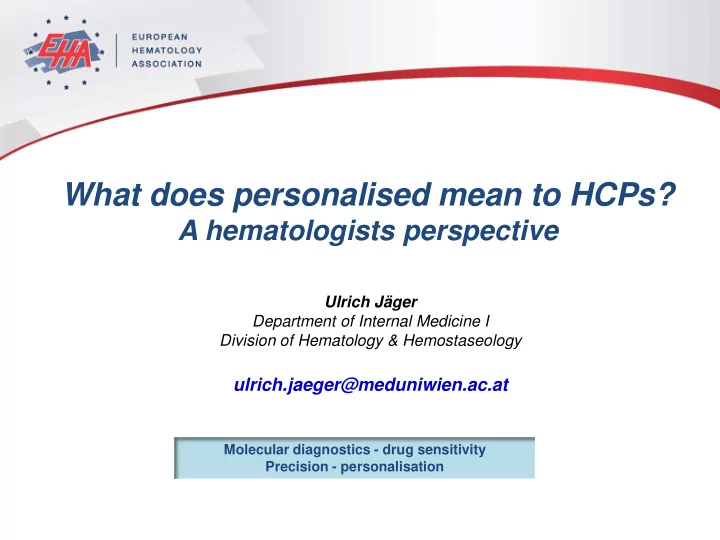

What does personalised mean to HCPs? A hematologists perspective Ulrich Jäger Department of Internal Medicine I Division of Hematology & Hemostaseology ulrich.jaeger@meduniwien.ac.at Molecular diagnostics - drug sensitivity Precision - personalisation
Personalised vs. Precision Medicine • The right patient • Refined diagnosis • Molecular profile of the tumor • Patient condition • Gender, age.... • Genetic profile • Comorbidities • The right treatment • Therapeutic intervention/drug • Targeted drug • Dose • Interactions • Duration
Precision Medicine • The right target • Refined diagnosis • Molecular profile of the tumor • The right treatment • Targeted therapy • Drug testing Precision Medicine 2017
Refined diagnosis Histology Immunophenotypi ng Cytogenetics Omics/Epigenetics Functional testing Functional testing Cellular therapy Cellular therapy Small molecules Immunotherapy Chemotherapy Radio therapy Increased Treatment Options Personalised treatment in Hematology
WHO Classification of lymphoid neoplasms - Revision 2016 >100 B- and T-cell lymphomas Personalized treatrment in Hematology
Gene mutations in B-cell lymphomas Gruber M and Wu CJ, Seminars in Hematology, Semin Hematol. 2014 Jul;51:177-87
Diagnostics • Prognostic (risk factors) • Predictive (response markers) • Biomarkers • Personal RF (age, sex, BMI, predisposition) • Genetic markers • Disease related RF • Dynamic markers (MRD) (markers, genetic) Ulrich Jäger 7 Division of Hematology and Hemostaseology
Evidence based initial therapy Treatment failure Phase I-III Precision Personalisation clinical studies Medicine Age, gender Enriched/preselected cohorts Molecular diagnosis Comorbidities Higher response rates Drug sensitivity testing Genomic profile Side effects Novel target/drug discoveries Precision Medicine 2017
Genome analysis (germline) http://genomaustria.at Precision Medicine 2017 – Genetic predisposition
Genome analysis (germline) http://genomaustria.at Precision Medicine 2017 – Genetic predisposition
Higher Rituximab concentrations in female patients 11000 AUCtotalm 10000 AUCtotalf 9000 8000 7000 AUC 6000 5000 4000 3000 2000 AUC male: only 81% compared to females 1000 0 Ind 1 Ind 6 Main 1 Main 6 • Jäger U, et al . Haematologica 2012; 97:1431–1438. Personalised Medicine – Jaeger U et al Haematologica 2012 AUC tot. [mg/L*days]
Evidence based initial therapy Treatment failure Phase I-III Precision Personalisation clinical studies Medicine Age, gender Enriched/preselected cohorts Molecular diagnosis Comorbidities Higher response rates Drug sensitivity testing Genomic profile Side effects Novel target/drug discoveries Precision Medicine 2017
Individualized Treatment according to Molecular Profile of the Individual Patient Von Hoff D D et al. JCO 2010;28:4877-4883 after Failure of Standard Treatment. n=66 n=2 von Hoff D D et al. JCO 2010;28:4877
Comparisons of PFS on Molecular Profiling (MP) Therapy vs. PFS on Prior Therapy for 18 out of 66 Patients with a PFS ≥ 1.3. von Hoff DD et al. JCO 2010;28:4877
SHIVA-Trial: Progression Free Survival C. Le Tourneau et al., The Lancet Oncology 2015 16, 1324-1334DOI: (10.1016/S1470-2045(15)00188-6)
EXALT eukemia EXtended Analysis for L Treatment ymphoma Pathological Fresh tissue/ Genetic Tissue archiving routine bone marrow/ (FFPE, DMSO) profiling evaluation blood Cell Suspensions Normal vs malignant Target profiling Drug screening Diff. expressed Specif. active targets drugs Tissue Cells EXALT-Board discussion: Information Prescription of individual therapy
Pharmacoscopy: Next generation functional drug sensitivity testing 1. Treatment guidance 2. Diagnostics 3. Drug discovery Snijder B, Vladimer G,...Jaeger U, Staber P, Superti-Furga G et al, in preparation
EXALT + pharmacoscopy drug testing: Correct prediction of response in acute myeloid leukemia cKit+, CD34* Berend Snijder Hye-Soo Choi Gregory Vladimer Stefan Kubicek
EXALT & Next generation functional drug screening: Comparison between last prior therapy and pharm acoscopy- guided treatm ent in relapsed hematologic malignancies: 70% of patients (12/ 17) have a PFS ratio > 1.3 (CI=44-84; P<10 -6 ) PFS on last PFS on EXALT prior therapy selected therapy Period A Period B PFS on last prior therapy PFS (weeks) PFS on EXALT selected therapy Snijder B, Vladimer G,...Jaeger U, Staber P, Superti-Furga G et al, in preparation 19
Intent to treat in personalised trials: Limitations Patient informed consent, sampling (n =57) Not sufficient material (n = 5) Worsening condition (n = 3) Lost follow up (n = 1) EXALT-Board (n=48) Drug not available (n = 6) Worsening condition (n = 8) Lost follow up (n = 4) Treated according to EXALT Treated differently to PC/EXALT * (n = 17) (n = 13) PFS on last PFS on EXALT clinicians’ choice (n = 9) prior therapy selected therapy biomarker based (n = 4) Period A Period B Snijder B, Vladimer G,...Jaeger U, Staber P, Superti-Furga G et al, in preparation 20
Chemosensitivity in individual patient samples: Identification of drug patterns in hematologic cancers Drugs Diagnosis 100 0 50 Viability (% of control)
CAR-T cells: genetically modified immune cells a Cellular reprogramming and ex vivo expansion are conducted at a cell processing facility.
Decision making in the era of personalised medicine How does the doctor know?
Personalized medicine: Time management... • 7-12 minutes door to door Involve patients! EudraCT-Nr. 2010-024262-22, „TIGER“ Study in CML
Precision Medicine Single doctor ´ s choice vs. Team decision (specialised centers) Molecular/drug testing tumor boards 2017
Conventional Clinical Studies • Smaller patient cohorts • More centers and networks required • Enrichment of potential responders in trials (RR from 30% to 60%) • Predictive markers (Biomarkers) (harmonized methods!) • Pretesting Novel Trial Designs • Basket trials • Drug accessibility only 30-50% • Response criteria • End points Precision Medicine 2017
Challenges Posed by Personalised Medicine • Common diseases are fragmenting • Every disease will be a molecular ‘orphan disease’, Networks required • But many diseases share similar molecular ‘faults’, and will have common therapies • Small populations of available patients • Trials have to find the ‘right’ patients • Diagnostics need to be available • Small safety datasets for approval • Privacy and use of tumour samples / marker information • The target keeps moving • Multiple, interdependent molecular pathways and the escape routes • Science moves much faster than clinical trials • Trials slow, expensive, highly regulated, inflexible • Large trials required to find the small population who benefit • Small studies in selected population may miss those who benefit Christoph Zielinski & Ulrich Jäger
Recommend
More recommend